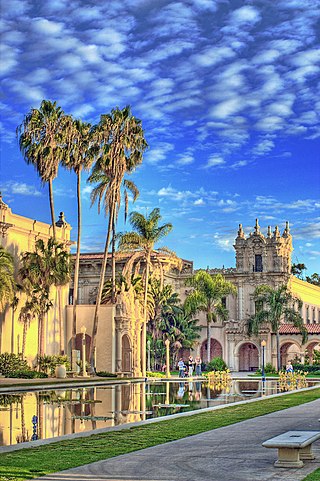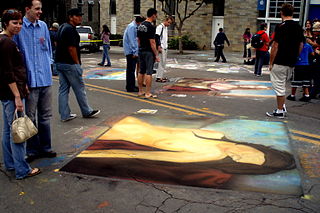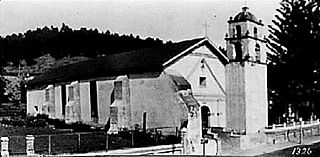| Moreton Bay fig | |
|---|---|
 The tree in 2016 | |
| Coordinates | 32°43′58″N117°08′51″W / 32.73275°N 117.14748°W |
| Date seeded | 1914 |
The Moreton Bay fig tree in San Diego's Balboa Park is one of the largest trees in California. [1] [2] [3] [4]
| Moreton Bay fig | |
|---|---|
 The tree in 2016 | |
| Coordinates | 32°43′58″N117°08′51″W / 32.73275°N 117.14748°W |
| Date seeded | 1914 |
The Moreton Bay fig tree in San Diego's Balboa Park is one of the largest trees in California. [1] [2] [3] [4]
It began its life when it was planted in 1914. [5] During the Panama–California Exposition it was part of the San Diego County garden exhibit; as of 2017 it is the last remaining plant from the exhibit. [6] The area underneath it was fenced off to the public in 1989 due to damage to the fig caused by foot traffic. [5]

The San Diego Zoo is a zoo in Balboa Park, San Diego, California, housing 4,000 animals of more than 650 species and subspecies on 100 acres (40 ha) of Balboa Park leased from the City of San Diego. Its parent organization, San Diego Zoo Wildlife Alliance, is a private nonprofit conservation organization, and has one of the largest zoological membership associations in the world, with more than 250,000 member households and 130,000 child memberships, representing more than a half million people.

Ficus macrophylla, commonly known as the Moreton Bay fig or Australian banyan, is a large evergreen banyan tree of the Mulberry Family (Moraceae) native to eastern Australia, from the Wide Bay–Burnett region in the north to the Illawarra in New South Wales, as well as Lord Howe Island where the subspecies F. m. columnaris is a banyan form covering 2.5 acres or more of ground. Its common name is derived from Moreton Bay in Queensland, Australia. It is best known for its imposing buttress roots.

The Panama–California Exposition was a world exposition held in San Diego, California, between January 1, 1915, and January 1, 1917. The exposition celebrated the opening of the Panama Canal, and was meant to tout San Diego as the first United States port of call for ships traveling north after passing westward through the canal. The fair was held in San Diego's large urban Balboa Park. The park however also had a second Panama-California exposition again in 1935.

San Diego Air & Space Museum is an aviation and space exploration museum in San Diego, California, United States. The museum is located in Balboa Park and is housed in the former Ford Building, which is listed on the US National Register of Historic Places. SDASM was established by articles of incorporation on October 12, 1961, and opened to the public on February 15, 1963.


Phoenix canariensis, the Canary Island date palm or pineapple palm, is a species of flowering plant in the palm family Arecaceae, native to the Canary Islands off the coast of Northwestern Africa. It is a relative of Phoenix dactylifera, the true date palm. It is the natural symbol of the Canary Islands, together with the canary Serinus canaria. Mature P. canariensis are often used in ornamental landscaping and are collected and transplanted to their new planting location. A Canary Island date palm with 10 m (30 ft) of trunk is about 60 years of age.

The California Pacific International Exposition was an exposition held in San Diego, California during May 29, 1935–November 11, 1935 and February 12, 1936–September 9, 1936. The exposition was held in Balboa Park, San Diego's large central urban park, which had also been the site of the earlier Panama-California Exposition in 1915.

Katherine Olivia Sessions was an American botanist, horticulturalist, and landscape architect closely associated with San Diego, California, and known as the "Mother of Balboa Park."

The culture of San Diego, California is influenced heavily by American and Mexican cultures due to its position as a border town, its large Hispanic population, and its history as part of Spanish America and Mexico. San Diego's longtime association with the U.S. military also contributes to its culture. Present-day culture includes many historical and tourist attractions, a thriving musical and theatrical scene, numerous notable special events, a varied cuisine, and a reputation as one of America's premier centers of craft brewing.



The Museum of Us is a museum of anthropology located in Balboa Park, San Diego, California, and is housed in the historic landmark buildings of the California Quadrangle.

Switzer Canyon is a canyon in San Diego, California. It is situated to the east of Balboa Park and serves as the boundary between the neighborhoods of North Park and South Park in Central San Diego. Switzer Canyon remains an oasis of natural vegetation between some of the city's most urban neighborhoods and is a prime example of San Diego county's unique canyon-laced topography.

Balboa Park is a 1,200-acre (490 ha) historic urban cultural park in San Diego, California, United States. In addition to open space areas, natural vegetation zones, green belts, gardens, and walking paths, it contains museums, several theaters, and the San Diego Zoo. There are also many recreational facilities and several gift shops and restaurants within the boundaries of the park. Placed in reserve in 1835, the park's site is one of the oldest in the United States dedicated to public recreational use. Balboa Park is managed and maintained by the Parks and Recreation Department of the City of San Diego.

The California Quadrangle, California Building, and California Tower are historic structures located in Balboa Park in San Diego, California. They were built for the 1915–16 Panama-California Exposition and served as the grand entry to the Expo. The buildings and courtyard were designed by architect Bertram Goodhue. They were added to the National Register of Historic Places on May 17, 1974. They now house the Museum of Us.

Clinton Gilbert Abbott was an American ornithologist, naturalist, and Director of the San Diego Natural History Museum from 1922 to 1946. Abbott supervised the construction of the museum's current building in Balboa Park, expanded research field trips and expeditions, and participated in important conservation efforts in southern California and the Baja California region. He was instrumental in the preservation of the southern California desert area that became Anza-Borrego Desert State Park.

Albert Robert Valentien (1862–1925) was an American painter, botanical artist, and ceramic artist. He is best known for his work as the chief ceramics decorator at Rookwood Pottery, and for his watercolor paintings of botanical subjects. In 1908, he accepted a commission from philanthropist Ellen Browning Scripps to illustrate the botanical diversity of California. Over the next ten years, he produced approximately 1200 watercolor "plant portraits" of native California wildflowers, grasses, ferns, and trees.

Ethel Bailey Higgins was an American botanist and the curator of botany at the San Diego Natural History Museum from 1943 to 1957; she continued to serve as associate curator from 1957 to 1963. Higgins authored Our Native Cacti (1931), and other popular works on plants of the southwestern United States and northern Mexico.

The City of Ventura Historic Landmarks and Districts consist of buildings, sites, and neighborhoods designated by the City of Ventura, California, as historic landmarks and districts.

The Moreton Bay Fig tree in the Palms neighborhood of Los Angeles is a large Ficus macrophylla tree that was planted in 1875 and landmarked in 1963. The St. John’s Presbyterian Church complex around the tree was established in 1962.